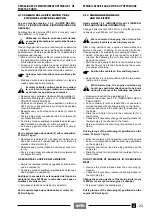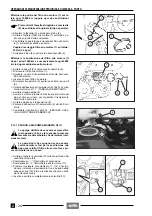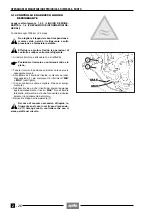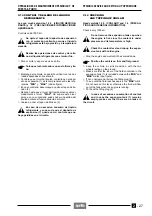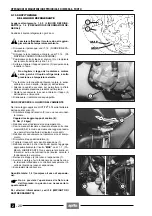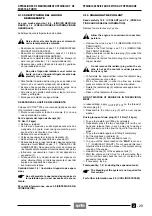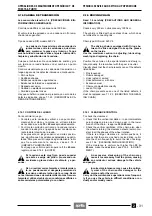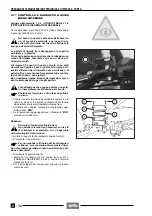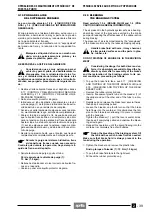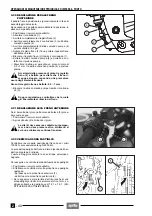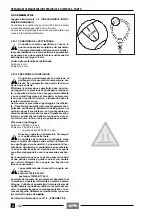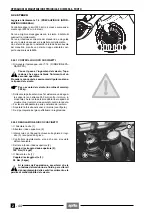
2
- 37
OPERACIONES DE MANTENIMIENTO PERIÓDICO Y DE
PUESTA A PUNTO
PERIODIC SERVICE AND SETTING UP OPERATIONS
2.18 CONTROL Y RELLENO
LIQUIDO FRENO TRASERO
Lea con mucha atención 1.2.4 (LÍQUIDO DE FRE-
NOS) y 1.4 (PRECAUCIONES E INFORMACIONES
GENERALES).
Controle tras los primeros 1000 km (o 4 meses) y sucesi-
vamente, cada 6000 km (o 8 meses).
En caso de una carrera excesiva de la palanca
del freno, de excesiva elasticidad o en caso
de presencia de burbujas de aire en el circui-
to.
Las pérdidas del líquido de freno dañan las superfi-
cies barnizadas o de plástico.
Antes de salir, controle que las tuberías no estén re-
torcidas o fisuradas y que no haya pérdidas en las
uniones.
Los sistemas de frenado de este vehículo han sido
llenados con líquido a base de glicol.
No use o mezcle diferentes tipos de líquidos a base
de siliconas o de petróleo.
No utilice líquidos que hayan estado en envases vie-
jos, usados o no cerrados herméticamente
No utilice nuevamente líquido que haya sobrado de
reparaciones anteriores y haya estado almacenado
por mucho tiempo.
Tenga cuidado en que agua o polvo no entren
en el interior del circuito.
Coloque el vehículo sobre un suelo firme y lla-
no.
◆
Mantenga el vehículo en posición vertical de manera
que el líquido contenido en el depósito (1) quede para-
lelo al
,
quede paralelo al borde del depósito.
◆
Compruebe que el líquido contenido en el depósito su-
pere la referencia "MIN" .
◆
Si el líquido no llega por lo menos hasta la referencia
"MIN" , rellene enseguida.
Relleno
◆
Desmonte el panel lateral derecho, véase 7.1.4
(DESMONTAJE PANELES LATERALES DERECHO
E IZQUIERDO).
Peligro de salida líquido. No accione la palan-
ca del freno trasero si se ha aflojado o quitado
el tapón del depósito líquido frenos.
◆
Desenrosque y quite el tapón (2).
Para no verter el líquido de los frenos durante
el relleno, se recomienda mantenga el líquido
en el depósito paralelo al borde del depósito (en po-
sición horizontal).
◆
Quite la junta (3).
◆
Llene el depósito (1) con el líquido frenos, véase 1.7
(TABLA DE LOS LUBRICANTES), hasta la referencia
"MAX" .
◆
Para volver a instalar los componentes, actúe siguien-
do el procedimiento en orden contrario.
a
a
c
a
c
2.18 CHECKING AND TOPPING UP THE
REAR BRAKE FLUID
Read carefully 1.2.4 (BRAKE FLUID) and 1.4 (PRE-
CAUTIONS AND GENERAL INFORMATION).
Check brakes after the first 1000 km (or 4 months) and
then every 6000 kms (or 8 months).
In case of excessive stroke of the brake lever,
of excessive elasticity or in case there is air in
the circuit.
The leak of brake fluid damages painted or plastic
surfaces.
Before setting out, make sure that the cables are not
twisted or holed and that there are no leakage from
the connectors.
The braking systems on this vehicle have been filled
with a glycol-based liquid.
Do not use or mix different types of silicone or oil-
based liquids. Do not use brake fluids taken from old
containers, used or not sealed.
Do not use liquids left over from earlier repair jobs
and stored for long periods.
Make sure that neither water nor dust acciden-
tally enter the circuit.
Position the vehicle on firm and flat ground.
◆
Keep the vehicle in vertical position, so that the fluid
contained in the tank (1) is parallel to the, so that the
brake fluid is parallel to the tank edge.
◆
Make sure that the fluid level exceeds the "MIN" mark.
◆
If the fluid does not reach the "MIN" mark, provide for
topping up.
Topping up:
◆
Remove the right side, see 7.1.4 (REMOVING THE
RIGHT AND LEFT SIDES).
The brake fluid may flow out of the tank.
Do not operate the rear brake lever if the brake
fluid tank plug is loose or has been removed.
◆
Unscrew and remove the plug (2).
In order not to spill the brake fluid while top-
ping up, keep the fluid in the tank parallel to
the tank rim (in horizontal position).
◆
Remove the gasket (3).
◆
Fill the tank (1) with brake fluid, see 1.7 (LUBRICANT
CHART), until it reaches the "MAX" mark.
◆
To reassemble the components, follow the reverse or-
der.
a
a
c
a
c
Содержание Pegaso 650
Страница 1: ......
Страница 3: ...0 4 NOTE NOTES ANMERKUNGEN ...
Страница 4: ...1 1 1 2 3 4 5 6 7 8 INFORMAZIONI GENERALI INFORMACIONES GENERALES GENERAL INFORMATION ...
Страница 42: ......
Страница 69: ...3 1 1 2 3 4 5 6 7 8 MOTORE MOTOR ENGINE ...
Страница 90: ...3 22 MOTORE NOTE NOTAS NOTES ...
Страница 91: ...4 1 1 2 3 4 5 SISTEMA DI ALIMENTAZIONE SISTEMA DE ALIMENTACIÓN FUEL SYSTEM ...
Страница 116: ...4 26 SISTEMA DI ALIMENTAZIONE NOTE NOTAS NOTES ...
Страница 117: ...5 1 1 2 3 4 5 6 7 8 IMPIANTO DI RAFFREDDAMENTO SISTEMA DE REFRIGERACIÓN COOLING SYSTEM ...
Страница 130: ...5 14 IMPIANTO DI RAFFREDDAMENTO SISTEMA DE REFRIGERACIÓN COOLING SYSTEM NOTE NOTAS NOTES ...
Страница 131: ...6 1 6 1 2 3 4 5 6 7 8 IMPIANTO ELETTRICO INSTALACIÓN ELÉCTRICA ELECTRICAL SYSTEM ...
Страница 176: ...IMPIANTO ELETTRICO INSTALACIÓN ELÉCTRICA ELECTRICAL SYSTEM 6 46 NOTE NOTAS NOTES ...
Страница 177: ...7 1 1 2 3 4 5 6 7 8 CICLISTICA PARTE CICLO CHASSIS PARTS ...
Страница 226: ... 67 3 57 2 66 6 3 576 7 50 5827 3267 5 25 58 75 6 5 5 5 ...
Страница 242: ... 67 3 57 2 66 6 3 576 7 66 5 12 17 5 25 5 12 17 52 5217 5 ...
Страница 246: ... 67 3 57 2 66 6 3 576 7 70 5 12 3267 5 25 5 12 75 6 52 5 5 5 ...
Страница 272: ... 67 3 57 2 66 6 3 576 7 96 NOTE NOTAS NOTES ...
Страница 273: ...8 1 1 2 3 4 5 6 7 8 INFORMAZIONI PER LE RIPARAZIONI INFORMACIONES PARA LAS REPARACIONES REPAIRS ...
Страница 301: ...INFORMAZIONI PER LE RIPARAZIONI INFORMACIONES PARA LAS REPARACIONES REPAIRS 8 29 E F E F G H G H ...
Страница 302: ...INFORMAZIONI PER LE RIPARAZIONI INFORMACIONES PARA LAS REPARACIONES REPAIRS 8 30 I L I M L N M N ...
Страница 303: ...INFORMAZIONI PER LE RIPARAZIONI INFORMACIONES PARA LAS REPARACIONES REPAIRS 8 31 O P Q P O R Q R ...
Страница 310: ...INFORMAZIONI PER LE RIPARAZIONI INFORMACIONES PARA LAS REPARACIONES REPAIRS 8 38 NOTE NOTAS NOTES ...
Страница 311: ...INFORMAZIONI PER LE RIPARAZIONI INFORMACIONES PARA LAS REPARACIONES REPAIRS 8 39 ...

